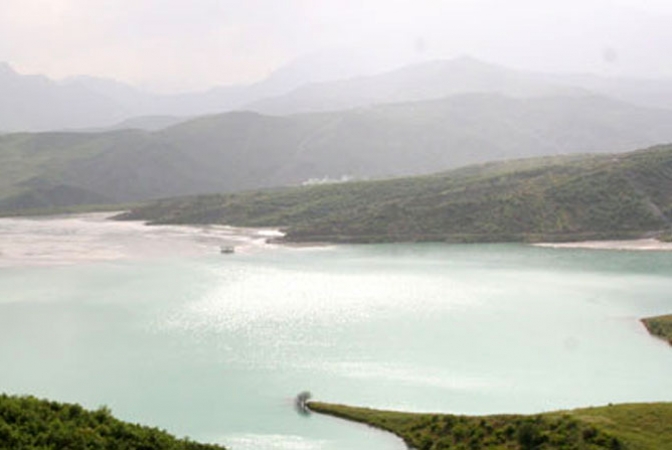The latest accident will cost ZCMC 6 million drams: the ministry is silent about previous cases. Hetq
This article by Marine Martirosyan originally appeared on Hetq Investigative Journalists website
Artsvik tailing
As a result of pollution of Norashenik river in Syunik Region, the National Environmental Inspectorate of the Ministry of Environmental Protection initiated an administrative proceeding against Zangezur Cooper Molybdenum Combine (ZCMC). The Chief of Staff of the Ministry Hovhannes Hovhannisyan informed Hetq about this.
On 25th of January, 2017 wastewaters of Artsvanik tailing poured into Norashenik River. 12 days after the accident the consequences were still not eliminated. The wastewater was flowing down the river. The president of Kapan’s Sustainable Development NGO Armen Parsadyan filmed the spill.
The ministry notes that based on the alert received on the 25th of January its National Environmental Inspectorate took wastewater samples from the exit of the forth tunnel of Artsvanik tailing and carried out physio-chemical expertise. “Elevated number of dependent particles” was recorded. An administrative proceeding was initiated based on this. Today the Ministry of Environmental Protection has announced that an environmental fee in the amount of 6.33 million Armenian drams (around 13.000$) has been calculated to be paid to the state budget.
In the inquiry to the ministry we had mentioned that the local residents periodically raise alarms regarding accidents in ZCMC. We asked if the ministry or any of its departments have held any discussions with the ZCMC on this issue and what measures the Ministry takes to avoid such accidents.
The ministry gave a general, evasive, meaningless response: “The National Environmental Inspectorate of the RA Ministry of Environmental Protection has proceeded with the claims of residents of the neighboring communities in accordance with measures prescribed by law”.
“Green light” to the ZCMC
As we wrote before, ZCMC aims to increase the annual production volume up to 22 million tons, which has raised serious concerns among the environmentalists. Expansion will mean more waste and pollution. We asked the position of the ministry on this, as well as what mechanisms will be developed to prevent damage to the environment. “On 16.12.2016 a positive conclusion was given for the environmental impact assessment EE 108 permitting ZCMC to expand its production capacity,” states the reply.
Case of Kapan Ore Processing Combine has been sent to the Prosecutor’s Office
Last year on 29th of November, as a result of a waste pipe accident at another company – Kapan Ore Processing Combine, an environmental damage assessed at 21 million 200 thousand drams (around 44.000USD) was caused. The ministry told Hetq reporter that the administrative proceedings initiated by the Syunik regional department of the Inspectorate for polluting the upper layer of soil caused by industrial waste spills was suspended on 24.01.2017 and the case materials were sent to the Syunik region’s Prosecutor’s office.
The ministry does not provide statistics, yet there are numerous accidents
We asked the Ministry to provide us with information regarding how many accidents (related not only to the tailing dumps) National Environmental Inspectorate has recorded from 2012 up to date caused by the activities of ZCMC and Kapan Ore Processing Combine (formerly belonging to “Dino Gold Mining Company”, then Canadian “Dundee Precious Metals Kapan”, now Russian “Polymetal” company) and in which cases the companies were fined. We asked to present the cases according to years and the amount of fine. In other words, we aimed to get exact statistics from the ministry about the damages to the environment as a result of the activities of the two industrial giants and on compensation.
Chief of staff H. Hovhanisyan replied: “From 2012 till today accidents resulted from the activity of Zangezur Copper and Molybdenum Combine CJSC have been registered in accordance with the law and the amount of compensation for damages was calculated, which can be found on the official website of the ministry.” The same answer was given for Kapan Ore Processing Combine (OPC). Seems that the ministry avoids showing exact statistics and quotes the site without specifying the sources of the materials.
Nevertheless, when examining the annual reports of work done by Ministry’s National Environmental Inspectorate, we see that only general situation is presented.
Thus, regarding the work done by the analytical laboratory of Syunik Regional Department, the 2012 annual report of the Ministry states that the laboratory monitors Voghchi, Vachagan, Geghi, Kavart, Norashenik, Vorotan, Vararakn, Karchevan rivers, outflows of Kapan OPC, ZCMC, Agarak CMC, Kajaran Public Utilities CJSC. In 2012 it found out the following “in the outflows of Kapan OPC the following substances exceeded the norm – ammonium: 3.2 mg/l (norm is 2.4 mg/l), nitrite: 2,5-3,2 mg/l (norm is 0.675 mg / l), nitrate: 6.5 mg/l (norm is 3.4 mg/l) ions. The environmental standards were also exceeded in the outflows of ZCMC, Agarak CMC and in Araks river; in case of copper: 0,019-0,158 mg /l (norm is 0,001- 0,08 mg / l). In the outflows of Agarak CMC dependent particles also exceed the environmental standards: 5020 mg/l (norm is 65 mg / l). In samples from Goris, Vorotan rivers ammonium exceeded: 1,8-2,1 mg/l (norm is 0.39 mg / l), nitrite: 0,9-2,2 mg / l (norm is 0.024 mg / l) ions, in samples from Voghchi river nitrite ion exceeded the standards: 1.2 mg / l (norm is 0.024 mg / l), in Karchevan River of Agarak dependent particles exceeded: 15,000 mg / l (norm is 65 mg / l). As to how much the company paid for these violations (if it paid at all), there is no information.
The website searching system of the ministry shows only two materials regarding the fines imposed on ZCMC. One of these is the latest violation, for which the fine has been calculated more than 6 million Armenian drams. The other dates back to 5 years ago. On August 20, 2012 there was an alarm that there had been an accident of metal pipeline in ZCMC resulting in rock mass spilling into the environment then pouring into the drain on the right side of the road to Geghi, some of it spilled into Voghchi river, as well as on the asphalt area covering about 100 meters.
As a result of comparing the analysis of the samples taken from the river Voghchi and the calculation of pipeline leak volume, around 38 tons of rock mass was registered, of which 28 tones poured into an open pool. Meanwhile, the damage was estimated just some 294 thousand drams (~610USD). “The area polluted with rock mass was immediately cleaned by the company, and about 7 cubic meters of solid residue was transferred to the emergency pool. No environmental damage was assessed for the mentioned polluted area, since there is no assessment envisaged for cases of pollution of industrial and transportation land areas”, said the ministry.
There is no information regarding the works of Syunik’s analytical laboratory dating to 2013. On that year, however, ministry held inspections at Kapan OPC and found out that article 15 on “Preservation of atmospheric air” was violated. This law is about requirements regarding air pollution emissions. There is no information if the company was held responsible.
In 2013 Hetq Investigative Journalists covered several accidents at ZCMC. On September 20-25 concentration in water pouring from Artsvanik tailing to Norashenik river exceeded the permitted limit. Syunik regional department of the National Environmental Inspectorate didn’t mention the exact amount of compensation, stating only an approximate number of 1 million Armenian drams.
A year before this, another accident at ZCMC caused waste waters flowing into Voghji river for 12 hours, yet the damage was assessed less than half million Armenian drams (less than 1000USD). There was a new accident on December 26, 2013 at Artsvanik tailing and again Norashenik river was suffering the damages.
On the same day as a result of an accident at the mine of “Ler-Eks”, tailings filled into Geghi river.
Syunik regional laboratory’s data for 2014 is presented in a general table, without specification of locations and names.
2015 data is also generalized, stating “For the mentioned period analysis was carried out at Dundee Precious Metals Kapan CJSC (Kapan OPC), ZCMC CJSC”. In 2015 the inspectorate monitored ZCMC and found out numerous violations, yet no information on liability.
As to 2016, the National Environmental Inspectorate states that as a result of its monitoring carried out at ZCMC and Kapan OPC by the laboratory between January-September, “Inspectorate warned the companies about secure exploitation of tailings, takes samples from waters flowing out of the tailings, assesses the damages to environment when necessary, gives oral or written recommendations for reducing cases of accidents”. The National Environmental Inspectorate also quickly reacted to accidents in 2016 and assessed the damages to environment.” Particularly on January 19, 2016 we wrote about exceeding concentrations in waters flowing out of Artsvanik tailing to Norashenik river.
The problem is the National Environmental Inspectorate’s narrative shows that discharges are numerous and continuous, yet the National Environmental Inspectorate doesn’t want to show the real picture as it doesn’t show the full statistics.
We asked the Ministry what happened with the project of Alyotig LLC regarding recycling the tailing dumps of Pukhrut, Voghji and Artsvanik (a project on which the National Assembly adopted a law in 2015). This company was declared bankrupt by Gegharkunik court on January 8, 2016. We asked the National Environmental Inspectorate if the project was annulled. Chief of staff H. Hovhannisyan answered that “the project of Alyotig LLC regarding recycling the tailing dumps of Pukhrut, Voghi and Artsvanik was not presented to RA Ministry of Nature Protection for expertise.”









